The Rosette Nebula is a vast emission nebula located about 5,200 light years away. The star forming region lies near a large molecular cloud in the constellation of Monoceros, the Unicorn. It is closely associated with the young open star cluster NGC 2244.
Also known as the Satellite Cluster, NGC 2244 appears at the centre of the Rosette. The hot young stars of the cluster were formed from the nebula’s material in the last 5 million years.
The stars in the Satellite Cluster are responsible for the nebula’s glow. Their radiation ionizes the surrounding clouds of nebulosity, causing them to emit their own light. The nebula glows in the red part of the spectrum because the powerful ultraviolet radiation from the stars strips electrons from the nebula’s hydrogen atoms.
The Rosette Nebula is a very active stellar nursery. It is home to numerous Herbig-Haro objects and Herbig Ae/Be stars, Bok globules, T Tauri stars and clusters of newly formed stars. The dark filaments of dust extending toward the centre of the nebula, sometimes called “elephant trunks,” are shaped by the stellar winds and radiation from hot young stars and electromagnetic forces.
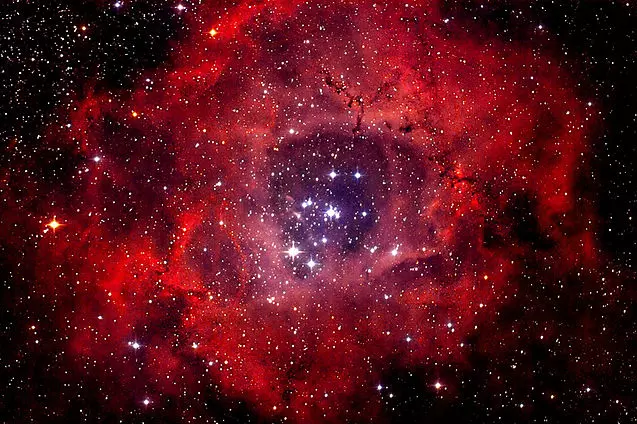
The Rosette Nebula with the Satellite Cluster (NGC 2244), image: Wikimedia Commons/Andreas Fink (CC BY-SA 3.0)
The Rosette (or Rosetta) Nebula spans 130 light years and has an angular size of 1.3 degrees. It is much larger than the better-known Orion Nebula, which is about 24 light years across. However, the Orion Nebula is much closer to us at 1,344 light years and appears brighter but smaller than the Rosette.
The Rosette Nebula has an estimated mass of about 10,000 solar masses. It is home to about 2,500 stars. The most massive O- and B-type stars power the nebula and cause it to expand. The nebula will disperse in the next few million years, leaving behind only the central cluster, NGC 2244.
The Rosette Nebula was named after the stylized flower design used in sculptural objects since antiquity. The nebula’s appearance in optical light resembles the rosette. It is sometimes called the Skull Nebula because it also closely resembles the human skull. It is not to be confused for the Skull Nebula (NGC 246), a planetary nebula in the constellation Cetus.
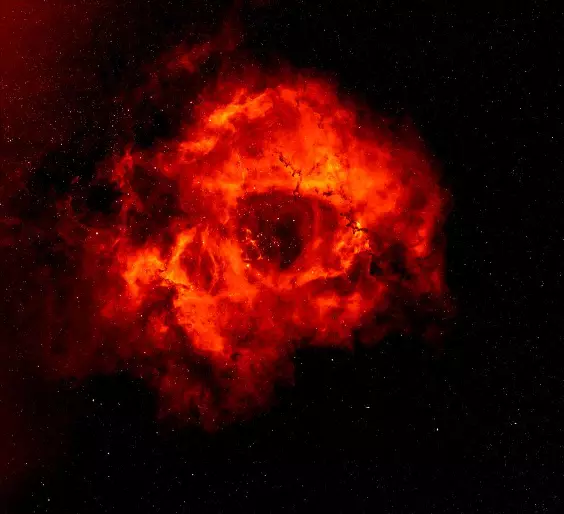
Rosette Nebula, image based on data obtained as part of the INT Photometric H-Alpha Survey of the Northern Galactic Plane, prepared by Nick Wright, University College London, on behalf of the IPHAS Collaboration (PD)
The region of the Rosette Nebula contains several stellar groups within 98 light-years (30 parsecs). The open cluster NGC 2244 occupies the central cavity and contains several tens of young, blue O- and B-type stars.
The nebula is also home to many low-mass young stellar objects: protostars and pre-main sequence stars (Herbig Ae/Be and T Tauri stars). Smaller stellar groups are found at the rim of the nebula.
NGC 2244: Satellite Cluster
The Satellite Cluster is a bright open cluster within the Rosette Nebula. It has an apparent size of 24 arcminutes, corresponding to a linear radius of about 18 light years.
Most of the stars in NGC 2244 are less than 5 million years old. The cluster has an estimated age of about 2 million years. A 2021 study found a mass of about 879 solar masses and a half-mass radius of 5.9 arcminutes (2.4 parsecs or 7.83 light years) for the cluster. The same study found that the cluster had a pattern of radial expansion and rotation.
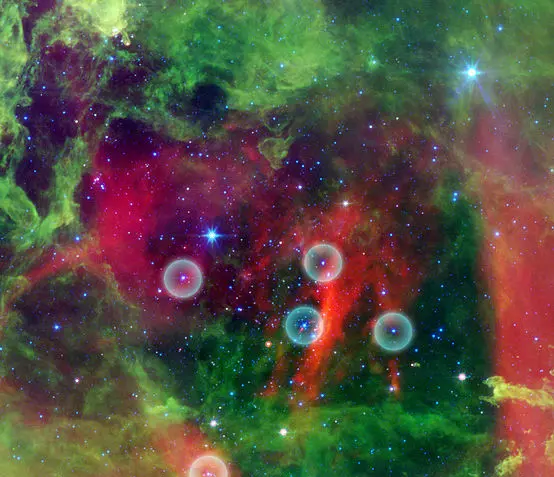
This infrared image from NASA’s Spitzer Space Telescope shows the Rosette nebula, a pretty star-forming region more than 5,000 light-years away in the constellation Monoceros. In optical light, the nebula looks like a rosebud, or the “rosette” adornments that date back to antiquity. But lurking inside this delicate cosmic rosebud are so-called planetary “danger zones” (see sphere illustrations). These zones surround super hot stars, called O-stars (blue stars inside spheres), which give off intense winds and radiation. Young, cooler stars that just happen to reside within one of these zones are in danger of having their dusty planet-forming materials stripped away. Image: NASA (PD)
NGC 2244 contains several exceptionally hot O-type stars that are mostly responsible for ionizing the surrounding nebula. The most massive members, catalogued as HD 46223 and HD 46150, are hot blue stars with stellar classifications O4V and O5V.
HD 46223 has a mass about 50 times that of the Sun and shines with 400,000 solar luminosities, while HD 46150 is up to 60 times more massive than the Sun and 450,000 times more luminous. The latter may be a double star. Both stars are less than 2 million years old. They are primarily responsible for blowing a bubble in the nebula’s centre.
Several stars that lie north and south of NGC 2244 are moving away from the cluster. Most of these stars were members of NGC 2244 about 2 million years ago.
The K-type giant 12 Monocerotis lies in the same line of sight as the cluster and appears as its brightest star. However, the star is around ten times closer to us and is not a member of NGC 2244.
The open cluster NGC 2237 lies near the heads of the gas pillars in the Rosette Nebula. Most stars in the cluster are moving toward the south, in contrast to the H II bubble, which is expanding west.
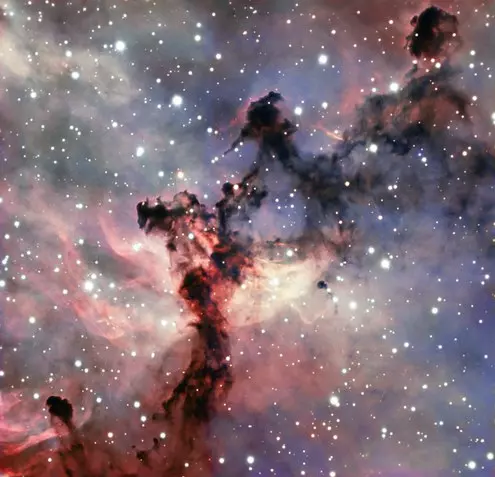
This colourful image shows a part of the Rosette Nebula in the constellation of Monoceros (The Unicorn). It is an emission nebula, composed of clouds of gas that are made to glow by the radiation emanating from stars within. The Rosette Nebula is a fairly typical example of an emission nebula — but typical does not mean boring! Nebulae are some of the most beautiful celestial objects out there, and they frequently show up spectacularly in images taken by astronomical telescopes, as seen here. In nebulae such as this, gas and dust are combining to produce a new generation of stars. Initially these newly-formed stars are shrouded in the dusty clouds that gave them birth, and cannot be seen in visible light. But after a while they blow away the denser material and their powerful radiation pours out to ionise the surrounding gas, causing it to glow brightly. These elements are all present in this image — the mixture of glowing gas and dark dust has been sculpted into complex patterns on the sky by the stellar radiation, like smoke around a fire. This particular image was obtained with the FORS 2 instrument on ESO’s Very Large Telescope, sited in the harsh environment of Chile’s Atacama Desert. FORS 2 is an extremely versatile instrument that can produce very high-quality images (like this one!). It is also a spectrograph that can split the light it collects into a rainbow of colours, giving astronomers information about the chemical composition of objects across the Universe. Image: ESO (CC BY 4.0)
Stars
The stars of the Rosette Nebula are members of the Monoceros OB2 association, a young association of stars that are not gravitationally bound. The Satellite Cluster forms the core of the association. It is the smallest of the three subassociations of Monoceros OB2, spanning 36 – 40 light years. The Rosette Nebula is the most active star forming region in the Monoceros OB2 association.
The massive stars in the nebula play a part in regulating star formation in their vicinity. Their stellar winds and far-ultraviolet radiation disperse the surrounding gas, reducing the efficiency of star formation and ultimately ending star formation altogether. However, the massive H II bubbles driven by the massive stars can compress the nebula’s material, triggering star formation away from the region excavated by these stars.
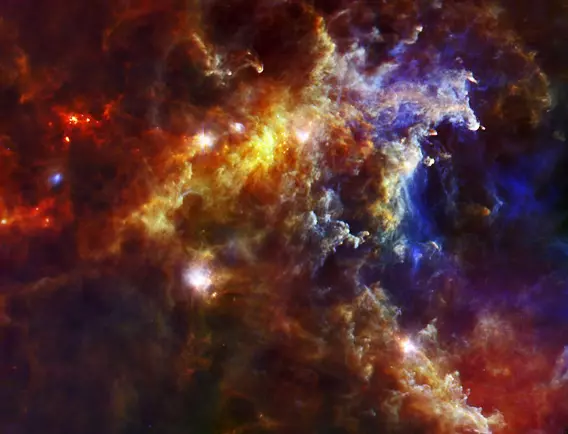
This image from the Herschel Space Observatory shows most the cloud associated with the Rosette nebula, a stellar nursery about 5,000 light-years from Earth in the Monoceros, or Unicorn, constellation. Herschel collects the infrared light given out by dust. The bright smudges are dusty cocoons containing massive embryonic stars, which will grow up to 10 times the mass of our sun. The small spots near the center of the image are lower mass stellar embryos. The Rosette nebula itself, and its massive cluster of stars, is located to the right of the picture. This image is a three-color composite showing infrared wavelengths of 70 microns (blue), 160 microns (green), and 250 microns (red). It was made with observations from Herschel’s Photoconductor Array Camera and Spectrometer and the Spectral and Photometric Imaging Receiver instruments. Herschel is a European Space Agency cornerstone mission, with science instruments provided by consortia of European institutes and with important participation by NASA. NASA’s Herschel Project Office is based at NASA’s Jet Propulsion Laboratory. JPL contributed mission-enabling technology for two of Herschel’s three science instruments. The NASA Herschel Science Center, part of the Infrared Processing and Analysis Center at the California Institute of Technology in Pasadena, supports the United States astronomical community. Caltech manages JPL for NASA. Image: ESA and the PACS, SPIRE & HSC Consortia (PD)
A 2003 study that used X-ray images obtained with the Chandra X-ray Observatory Advanced CCD Imaging Spectrometer (ACIS) instrument reported soft diffuse X-ray emission between the stars in the bubble. The extended emission is believed to be associated with hot plasma with temperatures in the range from 1 million to 10 million K.
This is considerably hotter than plasmas with temperatures of about 10,000 K generally observed in H II regions. It is believed to come from shock-heated winds from the massive young stars. The fast stellar winds of the nebula’s O-type stars are heated either by collisions with the winds from other stars or by a termination shock against the surrounding media.
A 2021 kinematic study of the young stars in the Rosette Nebula found that new stars in nebula may form through the expansion of stellar clusters, hierarchical star formation in turbulent clouds, and feed-back-driven star formation. The study identified a total of 338 young stellar objects within a region of 1 by 1 degrees.
A 2015 study found that 22% of the stars – about 560 stars – in the Rosette Nebula did not belong to a cluster. They may have formed in molecular filaments outside the main cluster. The filaments may later merge with the cluster.
Some of the massive stars in the Rosette Nebula will end their lives as brilliant supernovae. The shock waves from the supernova events will scatter much of the nebula’s dust and gas into the interstellar medium.
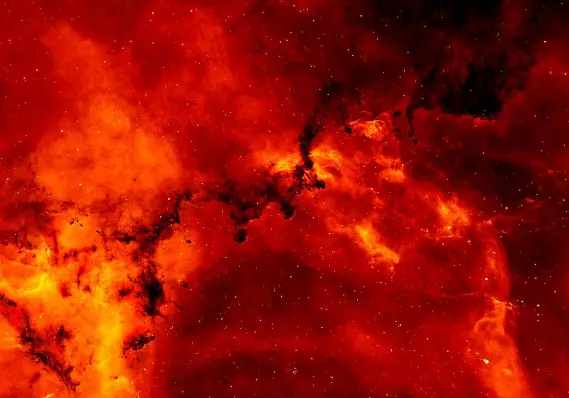
A close up view of the Rosette Nebula. The red color comes from hydrogen. Image based on data obtained as part of the INT Photometric H-Alpha Survey of the Northern Galactic Plane, prepared by Nick Wright, University College London, on behalf of the IPHAS Collaboration (PD)
Facts
Various parts of the Rosette Nebula have different designations in the New General Catalogue, and some of these are now obsolete (NGC 2238, NGC 2246). The designation NGC 2237, which denotes an open cluster west of NGC 2244, is often used for the whole nebula.
More commonly, the Rosette Nebula is referred to by its Caldwell designation, Caldwell 49, or by the designation Sharpless 275 (Sh2-275) from the Sharpless catalogue of H II regions.
Both the Rosette Nebula and the Satellite Cluster are included in the Caldwell catalogue of bright deep sky objects that can be observed with amateur telescopes. The two objects have separate Caldwell designations. The nebula is listed as Caldwell 49 and the cluster as Caldwell 50.
Different parts of the Rosette Nebula were discovered by different astronomers from the 17th to the 19th centuries. This is why the nebula has several designations in the New General Catalogue: NGC 2237, NGC 2238, NGC 2239, NGC 2244, and NGC 2246.
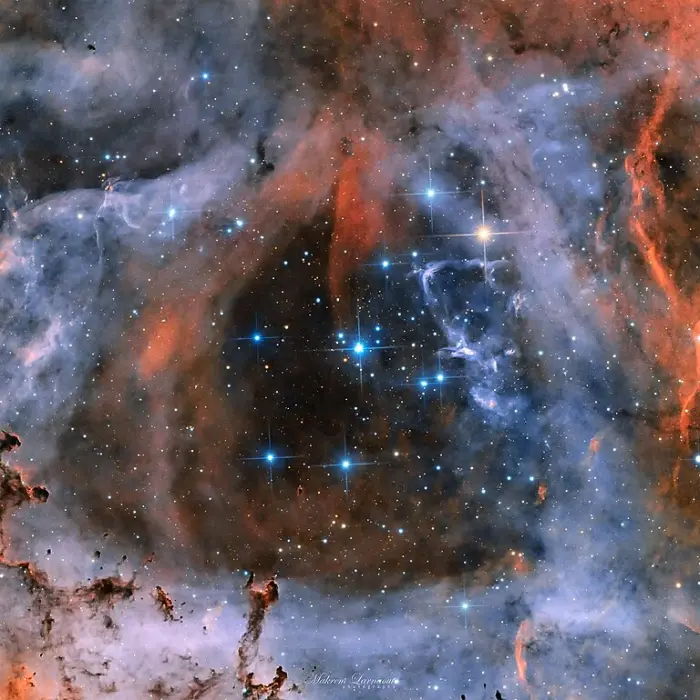
Rosette Nebula, image credit: Wikimedia Commons/Makrem Larnaout (CC BY-SA 4.0)
The open cluster NGC 2244 was discovered by the English astronomer John Flamsteed in 1690. The German-British astronomer William Herschel discovered the cluster independently about a century later, but like Flamsteed, he was unable to see the surrounding nebulosity. His son John Herschel is credited for the discovery of NGC 2239 in 1830. The Simbad database lists NGC 2239 as another designation for NGC 2244.
German astronomer Albert Marth was the first to see the Rosette Nebula. He discovered NGC 2238, a small bright patch in the nebula, in 1864 using a 48-inch reflector. American astronomer Lewis Swift was the first to report NGC 2246 (a bright patch on the eastern side of the Rosette) in 1886.
The different parts of the nebula are collectively catalogued as NGC 2237. The full extent of the nebula became known only after American astronomer Edward Emerson Barnard started his photographic work at the Lick Observatory at the University of California.
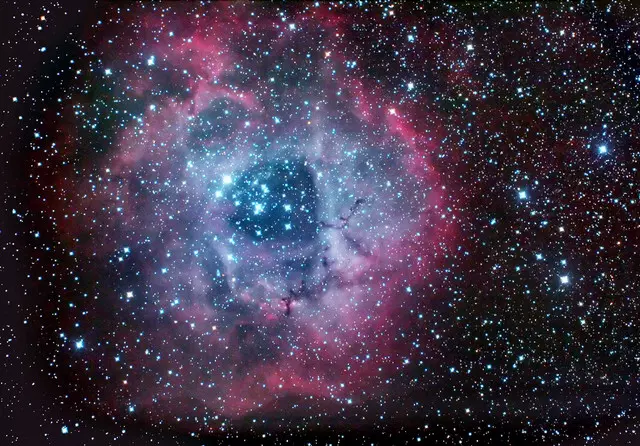
Rosette Nebula (H-alpha), image: Wikimedia Commons/John Lanoue (PD)
The Rosette Nebula lies in the Perseus Arm, one of our galaxy’s two major spiral arms. The Perseus Arm is also home to the Crab Nebula (M1) in Taurus, the Double Cluster (NGC 869 and NGC 884) in Perseus, and the open clusters Messier 36, Messier 37, and Messier 38 in Auriga.
The Rosette Nebula is one of the most popular targets for wide-field astrophotography. The nebula’s appearance, size, and location make it an attractive target for amateur telescopes. However, it is not an easy target for visual astronomy.
While the Satellite Cluster can be spotted even in binoculars and is best seen at low magnification, the surrounding nebula is best observed in larger telescopes at low power, with OIII or UHC filters. The Rosette may not fit in a single field of view, but its dark lanes will be more visible.
The nebula requires a clear, dark sky to be seen. Its red colour cannot be seen visually. It can only be captured photographically.
On April 16, 2019, the Rosette Nebula was adopted as the official astronomical object of the State of Oklahoma. The bill was signed into law by Governor Kevin Stitt on April 22, 2019.
In October 2024, the Rosette Nebula was captured by the Dark Energy Camera (DECam) to celebrate the fifth anniversary of the US National Science Foundation National Optical-Infrared Astronomy Research Laboratory (NOIRLab). The 570-megapixel wide-field CCD imager is mounted on the Victor M. Blanco 4-meter Telescope at Cerro Tololo Inter-American Observatory in Chile.
The DECam image provided new insights into the interactions between the nebula’s young stars, dark dust clouds, and ionized gas. It clearly showed the elephant trunks – dark, dense columns of dust – in which new stars are forming.
One of these dusty features, nicknamed the Wrench Trunk, is visible in the nebula’s central cavity. It is shaped by the nebula’s magnetic fields and twists through its clouds of dust and gas.
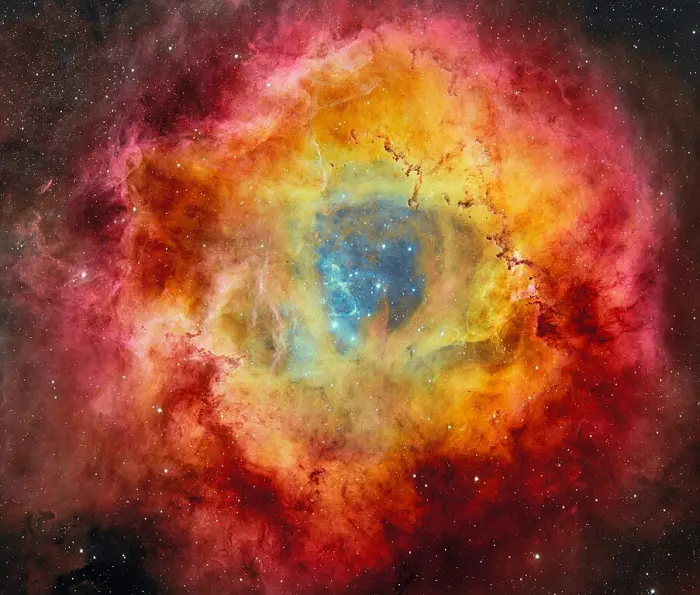
Cradled within the fiery petals of the Rosette Nebula is NGC 2244, the young star cluster which it nurtured. The cluster’s stars light up the nebula in vibrant hues of red, gold and purple, and opaque towers of dust rise from the billowing clouds around its excavated core. This image, captured by 570-megapixel Department of Energy-fabricated Dark Energy Camera (DECam), mounted on the U.S. National Science Foundation Víctor M. Blanco 4-meter Telescope at Cerro Tololo Inter-American Observatory, a Program of NSF NOIRLab, is being released in celebration of NOIRLab’s fifth anniversary. Credit: CTIO/NOIRLab/DOE/NSF/AURA; Image Processing: T.A. Rector (University of Alaska Anchorage/NSF NOIRLab), D. de Martin & M. Zamani (NSF NOIRLab) (CC BY 4.0)
How to find the Rosette Nebula?
The Rosette Nebula is easy to find because it lies between two first-magnitude stars. It appears just south of the imaginary line that connects Betelgeuse in Orion and Procyon in Canis Minor.
Betelgeuse is identified as the right shoulder of Orion (left from our point of view). It forms a prominent triangle with Procyon and Sirius, known as the Winter Triangle. Sirius in Canis Major and Alhena in Gemini can be used for orientation. The nebula lies just right of the imaginary line connecting the two stars.
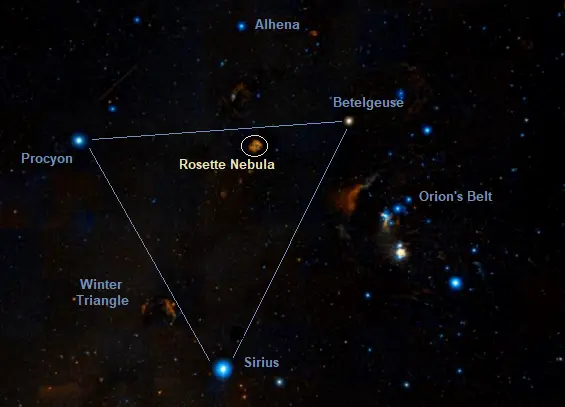
Location of the Rosette Nebula, image: Wikisky
On a clear night, the Rosette Nebula can be found within a faint triangle of stars that outline the head of the celestial Unicorn. The three stars – the A-type subgiant Epsilon Monocerotis (mag. 4.39), K-type giant 18 Monocerotis (mag. 4.47), and white supergiant 13 Monocerotis (mag. 4.5) – are all evolved, luminous stars, but they lie too far away to be visible from light-polluted areas.
Location
The Rosette Nebula lies in the northern part of the constellation Monoceros, the Unicorn. Monoceros is one of the fainter constellations. Its brightest stars, the giants Alpha and Gamma Monocerotis, shine at magnitudes 3.94 and 3.96. They are visible to the unaided eye, but do not stand out in this region of the sky, which contains more first-magnitude stars than any other area. However, the constellation can be identified on a clear, dark night because a good portion of it lies within the Winter Triangle, a prominent asterism formed by Sirius, Betelgeuse, and Procyon.
The best time of the year to observe the stars and deep sky objects in Monoceros is during the northern hemisphere winter, especially in the month of February, when the Winter Triangle dominates the evening sky.
Rosette Nebula – Caldwell 49
| Constellation | Monoceros |
| Right ascension | 06h 32m 26.76s |
| Declination | +04° 47′ 37.1″ |
| Apparent magnitude | 9.0 |
| Apparent size | 1.3° |
| Distance | 5,200 light years (1,600 parsecs) |
| Radius | 65 light years |
| Names and designations | Rosette Nebula, Caldwell 49, Sh2-275, CTB 21, ASB 27, LBN 949, LBN 206.39-01.87, LBN 948, 3C 163 |
Satellite Cluster – NGC 2244
| Right ascension | 06h 32m 10.8s |
| Declination | +04° 54′ 50′′ |
| Apparent magnitude | 4.8 |
| Apparent size | 24′ |
| Distance | 5,200 light years |
| Radius | 18 light years |
| Age | < 5 million years |
| Names and designations | Satellite Cluster, NGC 2244, NGC 2239, Caldwell 50, Collinder 99 |
Images
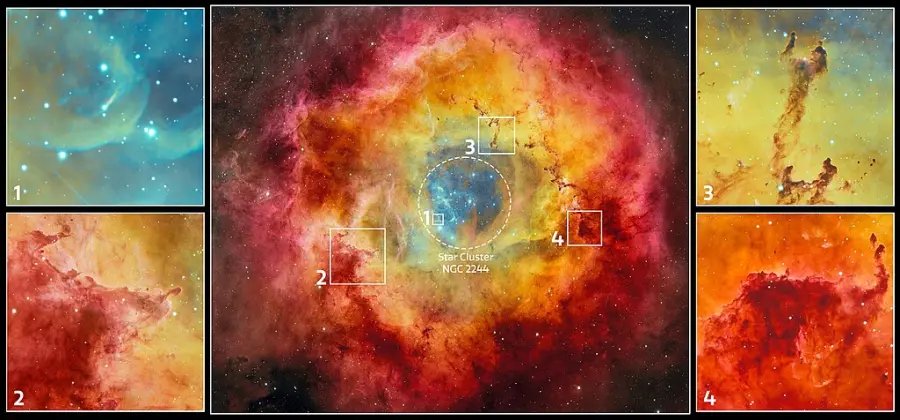
This excerpt shows some of the interesting features of the Rosette Nebula. The dashed circle highlights the nebula’s central star cluster, NGC 2244. The hazy smudge at the center of NGC 2244 is the young stellar object (YSO), Rosette HH1 (1). YSOs are stars in their early stage of evolution, before they become main-sequence stars, that often exhibit characteristics such as jets, bipolar outflows, protoplanetary discs, and other indicators of a new star being born. Around the nebula’s excavated nucleus is a string of dark clouds dubbed ‘elephant trunks,’ so-named because of their trunk-like pillars (2, 4) One of these dark features is the Wrench Trunk (3). Unlike the prototypical Pillars of Creation trunks which stand like straight columns, the Wrench’s ‘handle’ has an unusual spiral shape which traces the magnetic field of the nebula. Image credit: CTIO/NOIRLab/DOE/NSF/AURA Image Processing: T.A. Rector (University of Alaska Anchorage/NSF NOIRLab), D. de Martin & M. Zamani (NSF NOIRLab) (CC BY 4.0)
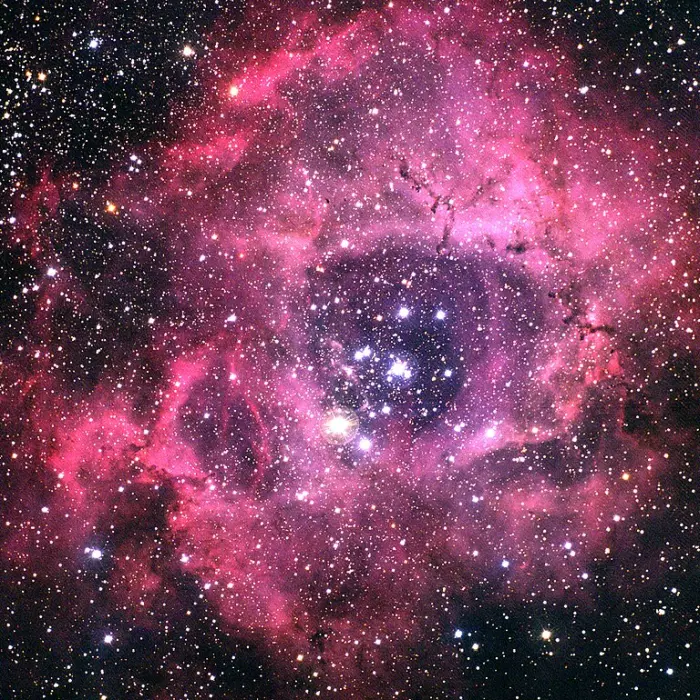
The Rosette Nebula in the constellation Monoceros. This image, despite being a degree across, still does not include the full size of this magnificent nebula. This color picture was made from CCD images taken in September 1997 at the Burrell Schmidt telescope of the Warner and Swasey Observatory of the Case Western Reserve University, located on Kitt Peak in southwestern Arizona. Image credit: N.A. Sharp /NOIRLab /NSF /AURA (CC BY 4.0)
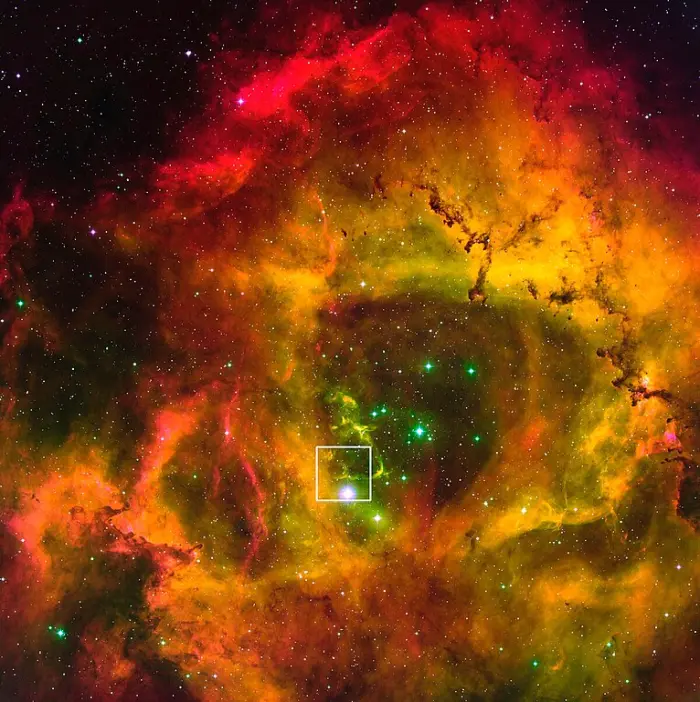
A reprocessed image of the Rosette Nebula (NGC 2237). In this image, a box has been drawn around the zoomed in area containing the jet Rosette HH1. Credit: T. Rector/University of Alaska Anchorage, WIYN and NOAO/AURA/NSF (CC BY 4.0)
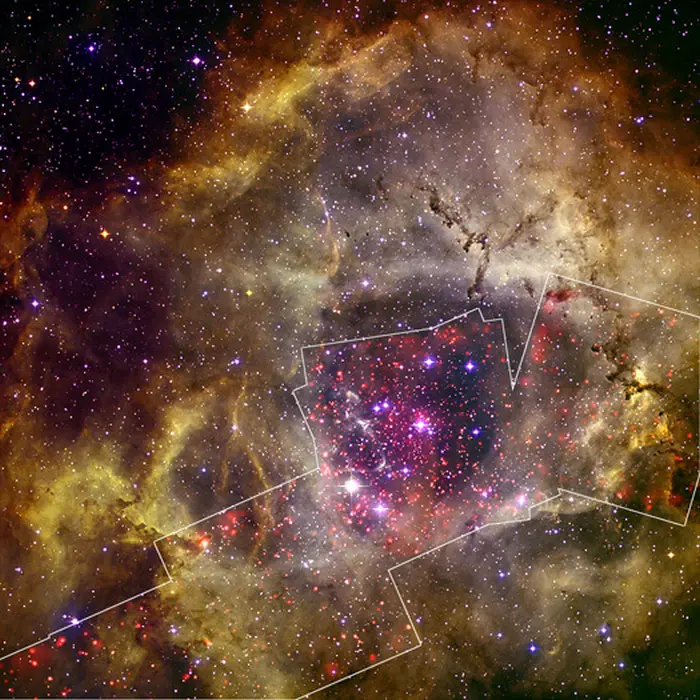
Rosette Nebula in X-ray and optical, credit – Credit X-ray (NASA/CXC/SAO/J. Wang et al), Optical (DSS & NOAO/AURA/NSF/KPNO 0.9-m/T. Rector et al) (PD)
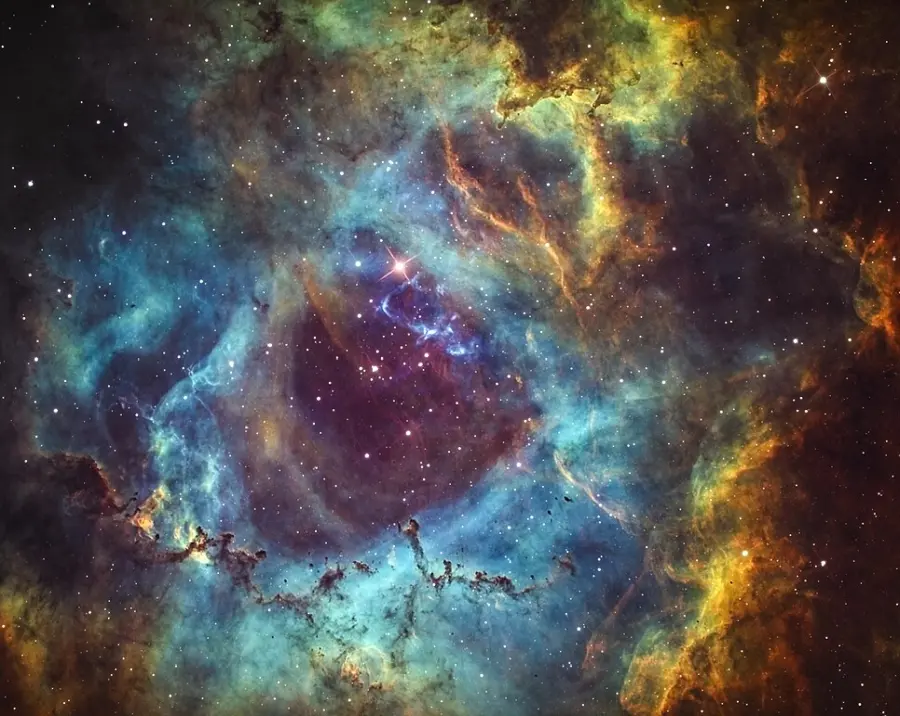
Rosette Nebula in SHO palette, credit: Wikimedia Commons/Darko7411 (CC BY-SA 4.0)
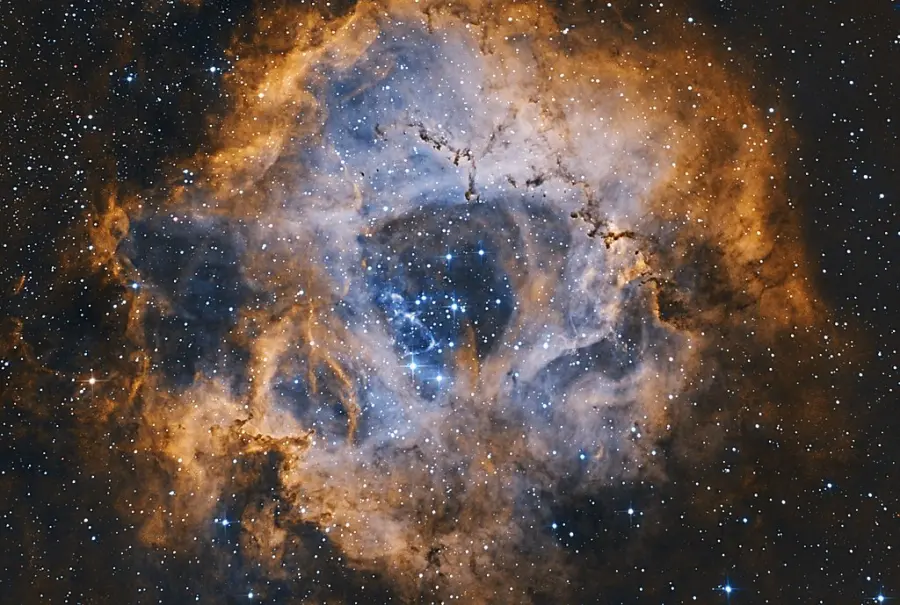
Rosette Nebula, credit: Wikimedia Commons/Nielander (CC BY-SA 4.0)
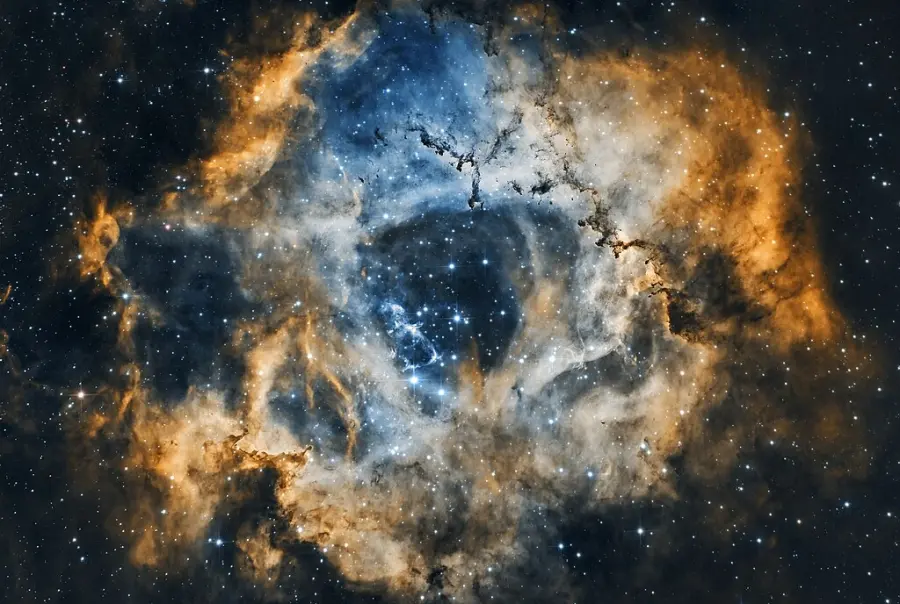
Rosette Nebula, credit:Wikimedia Commons/Nielander (CC BY-SA 4.0)